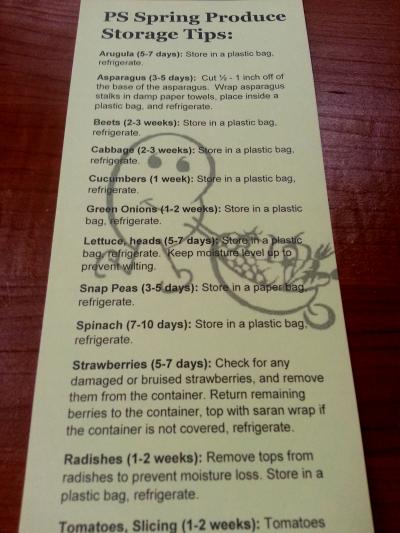 Rob M.
Rob M. | Spring, 2013: Produce Storage Tips
Apr 30, 2013 at 4:47 pm |
Arugula (5-7 days): Arugula is actually an herb in the mustard family. It is generally used similarly to salad greens, either as a substitute or as a complement. Arugula should be kept in a plastic bag to prevent moisture loss, and refrigerated. It will keep for just a few days. Arugula tends to be gritty, so don't forget to wash it just prior to using. If cooked, it should be added in just the last few minutes to prevent flavor loss and overwilting. Arugula makes a great pizza topping!
Asparagus (3-5 days): Cut Ĺ - 1 inch off of the base of the asparagus. Wrap asparagus stalks in damp paper towels, place inside a plastic bag, and refrigerate. The fresh cut on the base and damp paper towels will help the asparagus to retain and replenish moisture, extending storage life. Asparagus is best used within a few days, so try to use it at itís freshest.
Beets (2-3 weeks): Beet roots will keep best if the greens are separated from the bulbs. However, the greens will keep longest if kept on the bulb, which will provide the greens with moisture. It's a judgment call as to whether you will do best to remove the greens, or leave them on depending on your uses and timeframes for each. Beet greens will keep for up to a week, whereas bulbs will keep 2-3 weeks, so if in doubt you are probably better off keeping the two together. Beet greens can be used similarly to spinach or chard, and are the most nutritious part of the plant.
Cabbage (2-3 weeks): If possible, do not remove outer leaves from cabbage. Outer leaves protect interior from damage and from moisture loss. However, if refrigerator space is an issue, you can remove the outer leaves, and will have a smaller head of cabbage, just know that it won't keep quite as well. Cabbage can be used in portions, but once you cut into the interior of the cabbage, you will need to wrap the remaining portion tightly in saran wrap. Cabbage is a versatile vegetable that can be used raw as in coleslaw or cooked in a variety of ways. Cabbage is a food staple and is used in many types of cuisine.
Cucumbers (1 week): Cucumbers should be refrigerated and kept relatively dry. Over exposure to moisture can cause premature deterioration through mold. This is why English Cucumbers are commonly shrink wrapped, and grocery store cucumbers are often finished with a coat of wax. You can check the life of a cucumber by squeezing the ends. The ends generally turn squishy before the rest of the cucumber, so if they feel soft or start to look wrinkled, the cucumber is coming to the end of its storage life.
Green Onions (1-2 weeks): Cut off any damaged greens from the green onions bunch. You might also consider removing the rubber band, which can damaged the onion tops. Green onions should be stored in a plastic bag to retain moisture. They should be refrigerated, and will generally keep for a couple of weeks.
Greens, Collards, Kale, Chard (1-2 weeks): Greens should be placed in a plastic bag, and stored in the refrigerator. If greens start to look wilted, you can revive them by snipping the base of the stems, filling a tub with cold water, submerging the greens in the water, and placing the water tub in the refrigerator for 6-8 hours. The freshly snipped stems will soak up the cold water, and revitalize the greens. Grocery stores commonly use this trick before placing greens on their produce shelves.
Lettuce, heads (5-7 days): Lettuce loves moisture. Remove any wilted leaves, and dampen interior remaining leaves. Place in plastic bag, and store in refrigerator. Hearty lettuces like romaine tend to keep the longest, thinner leafed lettuces tend to wilt faster. If lettuce becomes wilted, you can revive it to an extent in a cold water bath. Fill a sink with cold water and a little ice, and submerge the lettuce for 10-15 minutes. The water will be absorbed by the plant, and can revive leaves that are starting to dry out or wilt. However, watch the lettuce carefully to guard against oversaturation and wet-rot.
Snap Peas (3-5 days): Snap peas should be stored in a paper bag and refrigerated. Snap peas only keep for a few days, and have the best flavor when used very fresh, so use them as quickly as possible.
Spinach (7-10 days): Spinach should be stored in a plastic bag to retain moisture. Spinach is generally rinsed by the farm, so it should have some moisture, but check the bag to make sure that it is not sitting in water. If it is, punch holes in the plastic bag, and drain any excess water. Store spinach in the refrigerator. It will keep for up to a week.
Strawberries (5-7 days): Check for any damaged or bruised strawberries, and remove them from the container. Damaged fruits release ethylene gas which signals other fruits to ripen at a faster rate. This means that one bad apple really does spoil the bunch. Berries can go bad quite quickly, so make sure they are covered, and store them in the coldest part of the refrigerator. However, strawberries will be at their juiciest at room temperature, so if possible bring them to room temperature prior to consuming.
Radishes (1-2 weeks): Remove tops from radishes to prevent moisture loss. Radishes should be stored in the refrigerator, and will keep for up to a week. Radishes have a peppery flavor that usually goes well in salads or in appetizers. The peppery flavor stimulated the production of saliva and rouses flavor, making them a good addition to pre-entree dishes. A simple radish appetizers includes sliced radishes served with melted butter and salt on the side. The peppery flavor is most concentrated in the radish skin, so they can be peeled for a milder flavor. Radish greens can also be used raw in salads, or cooked as you would other greens.
Tomatoes, Slicing (1-2 weeks): Tomatoes are best stored at room temperature. Refrigerating causes them to become mealy and lose much of their flavor. Check tomatoes occasionally for softening, and use softest tomatoes first. Softness is a sign of ripeness. In good condition, tomatoes will keep for 2+ weeks, but keep an eye on any bruised or dinged spots, as these will deteriorate faster than the rest of the tomato.
|   (Rob M.) (Rob M.) |